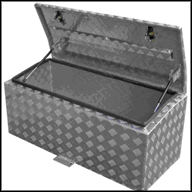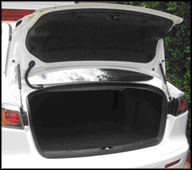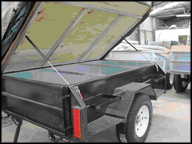Gas Struts
Issued: 26 February 2013
Last Updated: 26 February 2013
Purpose
The purpose of this safety alert is to highlight the potential risks associated with the use of gas struts.
Background
A man died at a Queensland camper trailer manufacturer while removing a gas strut. During the removal, the body separated from the shaft of the gas strut and was ejected at high speed, striking him in the head.
A failed gas strut is shown in Photograph 1.
Photograph 1: Gas strut similar to the one that failed |
Gas struts are used in many ways to give mechanical assistance to lifting and supporting components such as tool box lids, car bonnets, boot lids, rear doors and camping trailer hatches. Office chairs are another common use of a similar but different form of gas strut.
Photographs 2 - 4 Show some common uses of gas struts.
 |  |  |
Photographs 2 - 4: Typical uses for gas struts | ||
Contributing factors
Gas struts work by storing energy in the form of gas under pressure. This stored energy source is kept safe while the structure of the strut is intact. Struts contain nitrogen gas under pressure and some oil to damp movement and to lubricate the seals. Operating pressures are typically in the range of 1700 to 15200 kPa (250 to 2 200 psi).
Struts tend to fail in two main ways.
- Most failures are due to a gradual loss of pressure to the gas which results in the strut being unable to support the load. The risks are that the component being supported will gradually creep down or drop without warning.
- Struts can also fail if they have been internally damaged (for example by forced over-extension). There is a risk that the structure maintaining the gas pressure could give way and, with the sudden loss of restraining force, result in parts being ejected at high speed. In this instance, anyone in the area is at significant risk of severe injury or death due to the force of the impact.
Gas struts are usually installed or removed by hand which means that workers are very close to this potential hazard.
It is not always possible to know if a gas strut is damaged internally before removing it. It may appear to be operating normally, but the removal process may trigger a failure, causing an explosive ejection of parts. Care must be taken to manage the risks presented by damaged struts.
Gas struts may fail for a range of reasons, including:
- inappropriate design of the gas strut configuration (e.g. poor geometry subjecting the strut to over-extension, over-compression or side loading)
- inappropriate use (e.g. incorrect application or overheating)
- physical damage (e.g. from corrosion, wear, collision, leakage or misuse).
Action required
- The person conducting a business or undertaking (PCBU) who installs or removes gas struts should review their operating procedures to determine whether risks from the failure of gas struts are adequately controlled.
- The PCBU should ensure all people installing or removing gas struts are appropriately trained.
- The work area should be isolated from workers and others not involved in the installation and removal procedure.
- Workers should wear appropriate personal protective equipment.
- The gas strut configuration should be designed by a competent person and in accordance with the manufacturer's recommendations, including design, operation, orientation, load capacity and geometry.
- Gas struts should be installed and removed by a competent person in accordance with the manufacturer's recommendations. This may require the use of special tools.
- Gas struts should be protected against over-extension, side loading and excessive heat.
- Do not weld or apply heat to struts or adjacent areas as they may explode.
- Do not dispose of gas struts in fires as they could explode.
- Maintain a safe distance from burning vehicles due to the risk posed by exploding struts.
- Do not crush or puncture pressurised struts. Seek the manufacturers' advice about appropriate methods of depressurising.
Additional advice about the installation and removal of gas struts can be found in the manufacturer's instructions.
Further information
Further information may be obtained from the following codes: